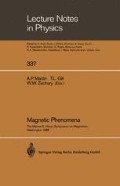Abstract
New phases and new morphologies are obtained for the magnetic elements by epitaxial growth on suitably prepared substrates. The tools of surface science and ultra high vacuum make possible the engineering of magnetic materials on an atomic scale. Epitaxy provides negative pressure for enhanced magnetic moments. Reduced symmetry at surfaces produces enhanced anisotropy, particularly through antisymetric exchange, Dzialishinski-Moriya, interactions. Reflection High Energy Electron Diffraction is used to characterize and control the deposition of Ni, Fe, and Mn on substrates of Ru, Fe, and Ag. Fe whiskers are particularly good substrates for studies of growth processes.
Preview
Unable to display preview. Download preview PDF.
Bibliography
B. Heinrich, A.S. Arrott, C. Liu and S.T. Purcell, New Phases of Manganese Achieved by Epitaxial Deposition, J. Vac. Sci. Technol. A5, 1935–1940, (1987)
A. S. Arrott and B. Heinrich, Crystallographic and Magnetic Properties of New Phases of Transition Elements Grown in Ultra Thin Layers by Molecular Beam Epitaxy, in “Metallic Multilayer and Epitaxy”, Ed. M. Hong, et al. (The Metallurgical Society, Pittsburgh, 1988) pp 147–166
A.S. Arrott, B. Heinrich, C. Liu and S. T. Purcell, Increased Magnetic Moments in Transition Elements Through Epitaxy, in “Thin Film Growth Techniques for Low Dimensional Structures” Eds. R.F.C. Farrow et al. (Plenum Press, New York, 1987) pp 287–310
A.S. Arrott, B. Heinrich, S.T. Purcell, J.F. Cochran and K.B. Urquhart, Engineering Magnetic Materials on the Atomic Scale, J. Appl. Phys. 61, 3721–3728 (1987)
B. Heinrich, et al., Large surface anisotropies in ultrathin films of bcc and fcc Fe(001), J. Appl. Phys. 63, 3863–3868 (1988); FMR study of ultrathin bcc Fe(100) films grown epitaxially on fcc Ag(100) substrates, Phys. Rev. Letters 59, 1756 (1987)
B. Heinrich, et al., Epitaxial Growths and Surface Science Techniques Applied to the Case of Ni Overlayers on Single Crystal Fe(001) in “Thin Film Growth Techniques for Low Dimensional Structures”, Eds. R.F.C. Farrow et al. (Plenum Press, New York, 1987) pp 521–543
B. Heinrich, et al., Structural and magnetic properties of ultrathin Ni/Fe bilayers grown epitaxially on Ag(001), Phys. Rev. B. 38, 12 879 (1988). See also, the Simon Fraser University PhD theses of S.T. Purcell and of K.B. Urquhart, (1989)
P. I. Cohen, P.R. Pukite, and S. Barra, Diffraction Studies of Epitaxy: Elastic, Inelastic and Dynamic Contributions to RHEED, in “Thin Film Growth Techniques for Low Dimensional Structures”, Eds. R.F.C. Farrow et al. (Plenum Press, New York, 1987) pp 521–543, B. A. Joyce et al., Dynamic RHEED Techniques and Interface Quality in MBE-Grown GaAs/(A1,Ga) As structures, ibid, pp 19–36
S.T. Purcell, A. S. Arrott and B. Heinrich, Reflection high-energy electron diffraction oscillations during growth of metallic overlayers on ideal and non ideal metallic substrates, J. Vac. Sci. Technol. B 6, 794 (1988); Intensity Oscillations for Electron Beams Reflected During Epitaxial Growth of Metals, Rapid Comm. Phys. Rev. B 35, 6458(1987)
J.F. Cochran et al., Anisotropies in Ultrathin Films of Iron Grown on Silver, J. Physique, in press K.B. Urquhart et al. Ferromagnetic Resonance measurements in ultrahigh vacuum on ultrathin films of bcc Fe(001) epitaxially deposited on fcc Ag(001 substrates, J. Appl. Phys. 64, 5334 (1988); S.T. Purcell et al., Structure and magnetic properties of epitaxial Ni layers on Fe(001) for various thicknesses, 64, 5337 (1988; J.R. Dutcher, et al., Brillouin light scattering studies of iron whiskers, 64, 6095 (1988).
A.S. Arrott, Dzialoshinski-Moriya Interactions about Defects in Antiferromagnetic and Ferromagnetic Materials, J. Appl. Phys. 34, 1108 (1963)
Author information
Authors and Affiliations
Editor information
Rights and permissions
Copyright information
© 1989 Springer-Verlag
About this paper
Cite this paper
Arrott, A.S. (1989). Engineering magnetic materials atom by atom. In: Maclin, A.P., Gill, T.L., Zachary, W.W. (eds) Magnetic Phenomena. Lecture Notes in Physics, vol 337. Springer, Berlin, Heidelberg. https://doi.org/10.1007/BFb0020699
Download citation
DOI: https://doi.org/10.1007/BFb0020699
Published:
Publisher Name: Springer, Berlin, Heidelberg
Print ISBN: 978-3-540-51428-2
Online ISBN: 978-3-540-69985-9
eBook Packages: Springer Book Archive

